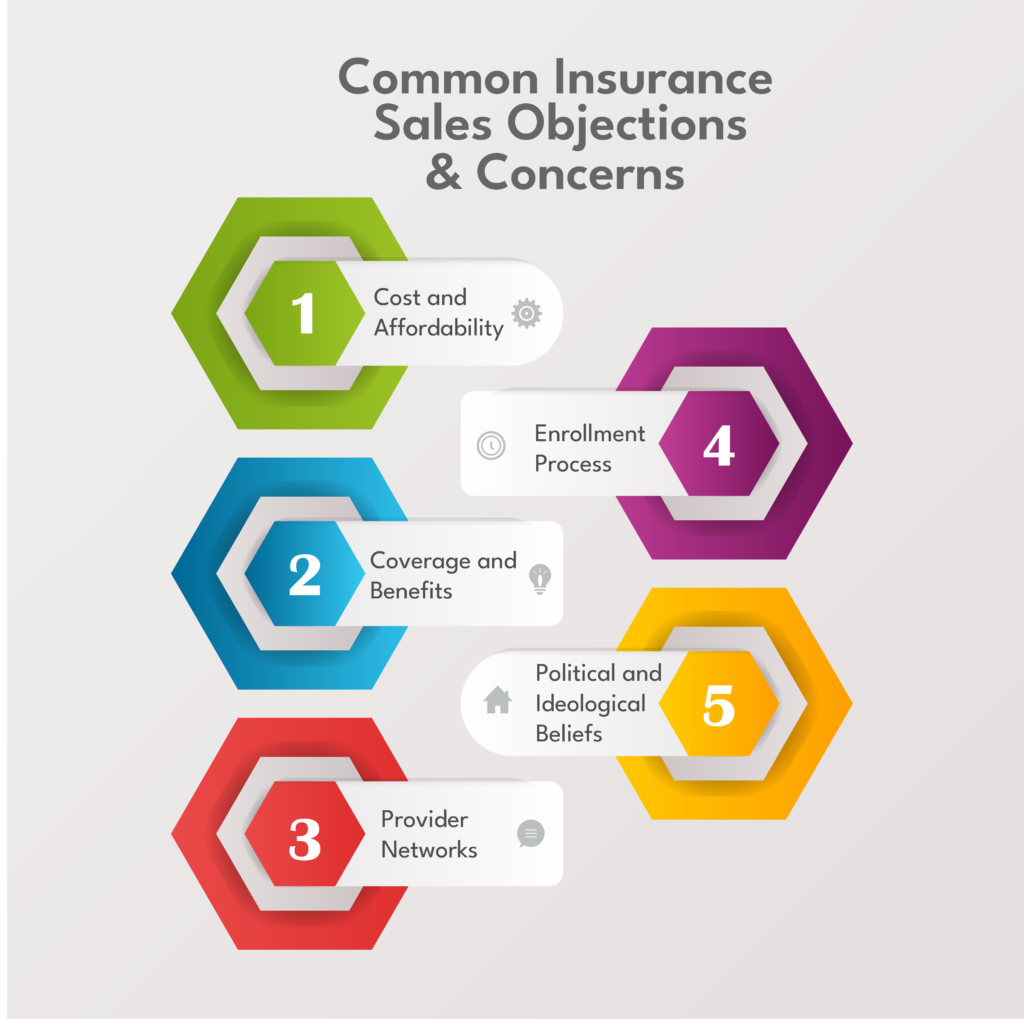
Want to know the common insurance sales objections and concerns regarding ACA?
Did you hear about the effective strategies for overcoming insurance sales objections?
Well, we will tell you each and everything regarding the typical objections raised by ACA leads. Read this blog till the very end and write down the concerns you have regarding ACA leads and in the next blog, we will cover it up for you.
Let’s begin:
In the realm of health insurance, the Affordable Care Act (ACA) has been a pivotal piece of legislation, aimed at making health insurance accessible and affordable to millions of Americans. However, as beneficial as the ACA is, potential enrollees often have concerns and objections that need addressing. Understanding these concerns and knowing how to effectively address them can significantly enhance lead generation and conversion rates.
This blog explores common insurance sales objections and provides strategies for addressing them, ensuring that potential ACA enrollees are well-informed and confident in their decision-making.
What is the Affordable Care Act (ACA)?
The Affordable Care Act, also known as Obamacare, was signed into law in 2010. It aims to increase health insurance quality and affordability, lower the uninsured rate by expanding public and private insurance coverage, and reduce healthcare costs.
Key Provisions of ACA:
- The Individual Mandate: Requires most Americans to have health insurance or pay a penalty.
- Health Insurance Marketplaces: Provide a platform for individuals to compare and purchase insurance plans.
- Medicaid Expansion: Extends Medicaid eligibility to more low-income individuals.
- Subsidies and Tax Credits: Help lower the cost of insurance for eligible individuals and families.
- Protections for Pre-existing Conditions: Prohibits insurance companies from denying coverage based on health history.
Despite these benefits, several common objections arise when discussing ACA plans with potential leads.
Common Insurance Sales Objections & Concerns:

However, it is necessary to differentiate the individual objections instead of all Insurance Sales objections that usually fit the general classifications first.
Common insurance sales objections typically revolve around:
- Cost and Affordability.
- Coverage and Benefits.
- Provider Networks.
- Enrollment Process.
- Political and Ideological Beliefs.
Table of Contents
Dealing With Cost and Affordability Issues:
The most frequently mentioned concern that ACA leads raise is the high costs of premiums and other expenses. Here are some strategies to address these concerns:
1. Defining subsidies and the kinds of financial help:
Admittedly, a majority of people are still ignorant of the subsidies that can be given to them under ACA. Illustrate how the Premium Tax Credit functions and how it’ll help make the monthly premiums considerably lower than before for eligible individuals. Practical and, if possible, quantitative examples should be used, and the estimated amount saved should be calculated taking into account their income and family size.
2. Explaining the Cost-Sharing Reductions:
To the consumers who have anxieties over high levels of out-of-pocket expenses, discuss on CSRs acronym for Cost-Sharing Reductions. Such cuts reduce the sum of money that people have to pay for such expenses as deductibles, copayments, and coinsurance, which in turn, makes healthcare services more accessible for individuals with low income levels.
3. Analyzing Your Costs to Other Insurance Plans:
Explain how ACA plans can be compared to other forms of insurance; for example, employer-based insurance or private insurance plans. Emphasize the eligibility for ACA plans and the incorporation of essential health benefits in ACA that may not be gotten in other plans.
4. Discussing Long-Term Financial Benefits:
Stress on the times when people pay for disease treatment if they have no health insurance, and what costs they can save when they are insured. Assist them in realizing that it is quite cost-effective to get health insurance as a backup when faced with any medical bills.
Tackling Coverage and Benefits Issues:
Another loophole often raised has to do with concerns pertaining issue of coverage and or benefits offered by ACA plans. Here’s how to address these concerns:
1. Teaching the aspects of Essential Health Benefits:
Emphasize the fact that all ACA plans do offer ten essential health services/ benefits that include the details such as hospital and emergency room services, prescription drugs, laboratories, Maternity and newborn care, Mental health and substance use disorder services including prescription drugs, and finally preventive services among others. This coverage guarantees that the enrolled patients receive the required healthcare services.
2. Adapting the Extent of Coverage to the Client’s Requirements:
Raise awareness with leads about the fact that there is a hierarchy of coverage levels (Bronze, Silver, Gold, and Platinum). It helps to understand the particularities of your clients’ health conditions and their wallets so that you can offer a plan that is both valuable and cost-efficient.
3. Highlighting Preventive Services:
Stress the fact that a substantial number of preventive services are provided with no out-of-pocket expenses. This comprises immunization, and briefing, which assist individuals in keeping off diseases and detecting them at their preliminary stage.
4. Discussing Out-of-Pocket Maximums:
Remind leads of the idea of out-of-pocket maximums to calm them down. After this dollar amount is met, the insurance company pays all covered services at 100% for the balance of the plan year. It can offer lots of financial shields in circumstances of critical health incidents.
Addressing Provider Network Concerns:
Another chief issue, that ACA leads have with their providers is related to provider networks. Here are ways to address these objections:
1. Clarifying Network Types:
Delve into the three network categories (HMO, PPO, EPO) and how they operate. This will assist the leads in comprehending the degree of flexibility in a network relative to cost. For instance, HMOs afford lower premiums for those clients but involve the use of referral physicians, and have narrow networks, while PPOs have wider networks but attract higher costs among other differences.
2. Checking Provider Availability:
Help leads ensure you verify some of the doctors they prefer, hospitals, and the specialists that are in the network. On average, the ACA plans have tools in place to help one search for providers within the network. This information eliminates the fear of not using their current healthcare facilities in case they opt for the plans.
3. Discussing Out-of-Network Coverage:
Explain the consequences associated with pragmatics and how it could affect the expenses. In case the clients’ preferred providers are out of network, make suggestions on what options they could consider or use in search of a network that the providers belong to.
4. Highlighting Telehealth Services:
Remote healthcare systems are today common and are part of the ACA’s healthcare plans. Telehealth has been described mostly as easy to access and readily available, thus the concern over where to get care may be addressed notably for those in rural areas or with disabilities.
Addressing Enrollment Process Concerns:
The enrollment process itself can be a source of anxiety for many potential enrollees. Here’s how to address these concerns:
1. Providing Step-by-Step Guidance:
Offer a clear, step-by-step guide to the enrollment process. This can include information on required documents, deadlines, and how to navigate the Health Insurance Marketplace website. Simplifying the process can make it less intimidating.
2. Offering Personalized Assistance:
Many individuals prefer personalized assistance when enrolling in a health plan. Offer to help them through the process, either in person, over the phone, or via online chat. Personalized support can significantly reduce anxiety and increase confidence in the process.
3. Explaining Special Enrollment Periods:
Ensure leads understand the concept of Special Enrollment Periods (SEPs) and the qualifying life events that can trigger them, such as marriage, childbirth, or loss of other coverage. This knowledge can provide peace of mind, knowing they have options outside the annual Open Enrollment Period.
4. Addressing Language Barriers:
For non-English speaking leads, offer information and assistance in their preferred language. This can include translated materials, bilingual support staff, or referral to community organizations that can help.
Addressing Political and Ideological Concerns:
There are several controversies regarding the ACA implementation based on political and political-ideological grounds. Addressing these concerns requires a delicate and respectful approach:
1. Focusing on Practical Benefits:
As much as possible, avoid discussing the politics of it and stress the advantages of having health insurance. Examine the aspects of the assurance that they are protected in the event they fall ill or get injured, the ability to receive checkups, and the cushion against hefty medical bills.
2. Highlighting Success Stories:
Encourage ACA enrollees to share success stories and/or testimonials of those who have received benefits from ACA plans. Personal narratives may be useful as a tool in making people shift their views regarding specific decisions or in illustrating the effects of the ACA.
3. Stressing On The Non-Political Character of Health Insurance:
Indicate that health insurance is a practical need after the political agenda is brought up. The objective is poverty reduction through the provision of health services by everyone across the political divide.
4. Providing Reputable Sources:
Brief information from credible and non-partisan sources for the remaining people who have doubts about the ACA. These can be websites of the authorities, official health-related organizations and institutions, research programs, and works that focus on the positive aspects and the efficiency of ACA.
Practical Tips For Addressing Insurance Sales Objections:

Here are some additional practical tips for addressing insurance sales objections and concerns:
1. Active Listening:
This means that while interacting with ACA leads, one must make use of the active listening technique. This is important so that they should be allowed to air their concern fully before one can respond to them. It demonstrates care and fosters trust in them and therefore makes them have an open ear to listen to your responses.
2. Tailored Responses:
Respond differently based on the lead’s particular problems and situations that they have indicated that they are experiencing. Telling them is not as good as explaining what they need, as it focuses on a general solution rather than personal requirements.
3. Using Visual Aids:
One can say that using different types of charts, infographics, comparison tables, and other visual materials, can make information easier to understand. These tools should be used to explain the advantages, disadvantages, and coverage of ACA plans.
4. Follow-Up Communication:
Although the conversation, always add some additional information or resource that helps them in their needs. This may be an email taking the candidate through websites that contain useful information, a phone call in case the candidate still has some questions, or scheduling a meeting to go through the plans in more detail.
5. Building Relationships:
The tips for initiating the leads’ relationship can help to build their trust and improve their enrollment chances. It is possible to contribute to people’s well-being through more frequent communication, individual approach, and genuine concern.
Conclusion – Insurance Sales Objections:
To effectively generate leads and sign people up for health coverage plans, it is crucial to recognize and respond to the different concerns that people have about ACA or the Affordable Care Act. From time to time, potential clients seek guidance on a range of issues related to health insurance programs, including their choice of a particular plan and provider of services. By investing time in paying attention to their concerns, giving precise information, and helping a client solve an issue, one can effectively contribute to the improvement of the health insurance enrollees’ decision-making process. Thus, different stakeholders must remember that while the main objective of enrolling people in a plan, the primary outcome is to make sure that they feel comfortable and content with the plan in question. The former has the potential to generate healthy outcomes and build a long-term healthy relationship with the target customers.
FAQ’S:
Q: What are the 4 types of objections in sales?
This is unfortunate because nearly all sales objections come down to one of these four things: need, urgency, trust, and money.
Q: What is a 3-step approach to handling objections?
Listen to the Issue. Repeat the Issue Back Clearly. Solve the Issue. Confirm the Issue Is Solved.
Q: What are the two types of objections?
Objections fall into two categories. There’s kind of a definite no, I don’t want to buy it. I don’t like your product. Or there’s the kind of delayed no, which is coming in the shape of things like I want to think about it or I want to speak to someone else.
